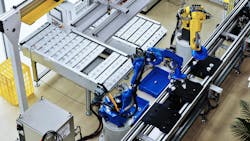How manufacturers are closing high-skill gaps
What you’ll learn:
- Manufacturing could see a shortfall of 1.9 million jobs by 2033.
- 90% of manufacturers are already using some form of AI.
- 79% say they plan to use AI tools specifically to tackle high-skill job shortages.
- AI diagnostic engines can reduce severe machine faults by as much as 90% and extend average equipment life by 10%.
Manufacturing faces a crisis: As the sector expands and evolves, high-skill jobs are going unfilled. In the U.S. alone, manufacturing could see a shortfall of 1.9 million jobs by 2033, making it difficult to stay competitive in global markets.
There’s a clear path forward. New research from Fluke Reliability and Censuswide indicates that manufacturers are turning to AI to bridge the skills gap and deliver greater operational efficiency.
See also: Agentic leaps past Gen-AI in its ability to solve production plant problems
AI-enabled processes like predictive maintenance and automation offer an effective way to upskill employees and extend the reach of the existing workforce, enabling teams to reach their productivity goals.
Identifying new use cases for AI
AI has achieved widespread market penetration in the last few years. Today, 90% of manufacturers are already using some form of AI. As the technology becomes more familiar, organizations are identifying specific use cases that meet their most pressing needs—many of which focus on expanding the capabilities of today’s workforce.
In the recent Fluke Reliability/Censuswide survey, nearly all manufacturers (98%) agreed that AI is a viable solution to the ongoing skills shortage. 79% say they plan to use AI tools specifically to tackle high-skill job shortages.
AI excels at data analytics, prediction, and automation—all of which make it a natural choice for filling high-skill analytic roles. AI tools are already being used to support proactive maintenance strategies, track inventory, and navigate supply chain issues. Looking ahead, we expect much greater use of the technology, with a resulting increase in operational efficiency throughout the manufacturing sector.
See also: Real use cases: Unlocking measurable efficiencies by harnessing AI
To be clear, AI doesn’t replace human technicians and decision-makers. AI is best used as a tool to complement and expand the capabilities of existing teams. As the manufacturing landscape grows more complex, AI allows companies to achieve more with fewer resources.
The changing nature of the manufacturing landscape
Over the past few decades, manufacturers have steadily incorporated new tools like Industrial Internet of Things (IIoT) sensors, robotics, and computer simulations. Today, the industry is struggling to find employees with the requisite skills to work in the new digital environment.
What is your company doing about cybersecurity?
According to Deloitte, 65% of manufacturers say attracting and retaining talent is their primary business challenge. The wider labor pool is also underprepared for technological shifts, as 60% of all employees will need some degree of reskilling by 2027, according to the World Economic Forum.
Webinar: Great Questions About Tariffs & Global Trade
For organizations on a lean budget, hiring expensive, high-skill workers may be out of reach. Likewise, carrying out extensive upskilling may be out of budget. That’s one reason that so many manufacturers are looking to AI to break through the constraints of the labor market and extend the reach of the current workforce.
Sharing workflows: collaborating with AI
AI is most effective when used as a copilot, sharing workflows with human operators. That’s how many maintenance, reliability, and operations (MRO) teams currently use AI in their work—as a way to fill in the gaps created by a lack of experienced, high-skilled technicians on staff.
Today, most manufacturers collect condition monitoring data in real-time via IIoT sensors. But most plants don’t have enough experts on hand to analyze the data within a meaningful timeframe. That’s where AI comes in.
See also: If AI isn’t the problem, what is? Maybe trust from frontline teams
AI-powered monitoring programs track sensor data on a continuous basis, scanning for anomalies and issuing alerts at the first sign of an emerging fault. With minimal training, machine operators can respond to AI-generated reports and take appropriate action, whether that means carrying out repairs or scheduling expert inspections.
The best AI tools issue detailed asset health reports, set maintenance priority levels, and generate specific guidelines for maintenance teams to follow so they can make the necessary repairs before machines ever get to the point of failure.
These capabilities enable organizations to implement predictive maintenance programs at a larger scale than ever before. And as AI continues to advance, it will deliver even more detailed guidance to maintenance teams to further workflow optimization.
See also: Way out of the talent shortage: AI as a catalyst for a workforce surge
Operators who aren’t trained to interpret raw data can now read and understand the reports generated by an AI diagnostic engine. Vibration experts are freed to focus on the jobs where they’re needed most. And managers can use AI’s recommendations to increase efficiencies, making it possible to oversee multiple worksites at once and grow the business further.
Leveraging AI for growth
Today’s manufacturing organizations rely heavily on data, software, and analytical processes. However, the labor shortage means that most companies don’t have the skilled teams they need to operate an Industry 4.0 worksite.
AI tools fill that gap. The technology’s unique combination of analytics and automation extends the reach of less-skilled workers, letting them achieve far more than before.
See also: New survey says manufacturers prefer AI copilots over autonomous agents
In real terms, AI diagnostic engines can reduce severe machine faults by as much as 90% and extend average equipment life by 10%. Organizations using AI can save 10% of their annual budget. These improvements can be felt throughout the organization, resulting in a far more efficient, productive company.
About the Author

Aaron Merkin
Aaron Merkin is chief technology officer at Fluke Reliability. As CTO, he oversees development and execution of Fluke’s industrial IoT strategy and is an experienced executive in technology and product strategy, solution architecture, M&A and organizational transformation. He has more than two decades of experience developing enterprise software across a variety of industries and markets at IBM, Dell, ABB, Aclara (now Hubbell), and Honeywell.
